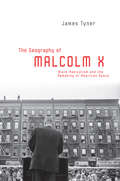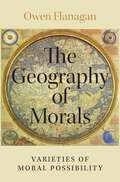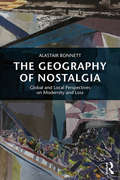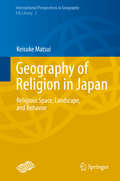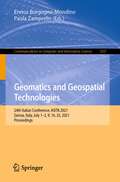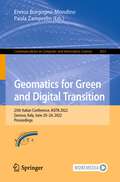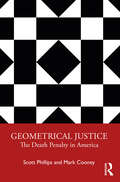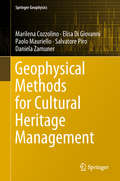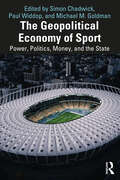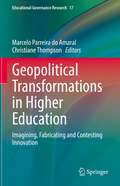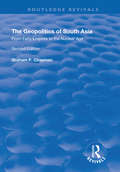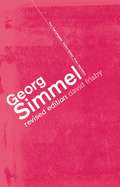- Table View
- List View
The Geography of Entrepreneurial Psychology (Entrepreneurship Footprints series)
by Martin Obschonka Michael Fritsch Michael StuetzerThe Geography of Entrepreneurial Psychology summarizes existing research and relevant insights from psychology, economics, management, sociology and geography to provide an overview to a new and innovative interdisciplinary field, answering the critical question 'what is a vibrant startup culture?' Mapping recent empirical advances and analysing regional differences in macro-psychological factors associated with entrepreneurship, the book discusses the role of historical trajectories of regional differences, considering their significance to contemporary entrepreneurial and geographical psychology. Chapters turn to established psychological theories, such as McClelland's Human Motivation Theory and the Big Five personality traits, to measure entrepreneurship culture and its persistence between regions and cities, delivering key implications for practice, education and policy in entrepreneurship. Setting a crucial agenda for future research, this cutting-edge book is vital reading for students and researchers of entrepreneurship cultures, particularly those focusing on regional differences. Psychologists and geographers will also benefit from this book’s multidisciplinary insights into spatial aspects of entrepreneurial psychology.
The Geography of Malcolm X: Black Radicalism and the Remaking of American Space
by James TynerFirst published in 2006. Routledge is an imprint of Taylor & Francis, an informa company.
The Geography of Malcolm X: Black Radicalism and the Remaking of American Space
by James TynerFirst published in 2006. Routledge is an imprint of Taylor & Francis, an informa company.
The Geography of Morals: Varieties of Moral Possibility
by Owen FlanaganThe Geography of Morals is a work of extraordinary ambition: an indictment of the parochialism of Western philosophy, a comprehensive dialogue between anthropology, empirical moral psychology, behavioral economics, and cross-cultural philosophy, and a deep exploration of the opportunities for self, social, and political improvement provided by world philosophy. We live in multicultural, cosmopolitan worlds. These worlds are distinctive moral ecologies in which people enact and embody different lived philosophies and conceive of mind, morals, and the meaning of life differently from the typical WEIRD -- Western, Educated, Industrialized, Rich, Democratic -- person. This is not a predicament; it is an opportunity. Many think that cross cultural understanding is useful for developing a modus vivendi where people from different worlds are not at each other's throats and tolerate each other. Flanagan presses the much more exciting possibility that cross-cultural philosophy provides opportunities for exploring the varieties of moral possibility, learning from other traditions, and for self, social, and political improvement. There are ways of worldmaking in other living traditions -- Confucian, Daoist, Buddhist, Hindu, Jain, Muslim, Amerindian, and African -- that citizens in Western countries can benefit from. Cross-cultural learning is protection against what Alasdair MacIntyre refers to as being "imprisoned by one's upbringing." Flanagan takes up perennial topics of whether there is anything to the idea of a common human nature, psychobiological sources of human morality, the nature of the self, the role of moral excellence in a good human life, and whether and how empirical inquiry into morality can contribute to normative ethics. The Geography of Morals exemplifies how one can respectfully conceive of multiculturalism and global interaction as providing not only opportunities for business and commerce, but also opportunities for socio-moral and political improvement on all sides. This is a book that aims to change how normative ethics and moral psychology are done.
The Geography of Morals: Varieties of Moral Possibility
by Owen FlanaganThe Geography of Morals is a work of extraordinary ambition: an indictment of the parochialism of Western philosophy, a comprehensive dialogue between anthropology, empirical moral psychology, behavioral economics, and cross-cultural philosophy, and a deep exploration of the opportunities for self, social, and political improvement provided by world philosophy. We live in multicultural, cosmopolitan worlds. These worlds are distinctive moral ecologies in which people enact and embody different lived philosophies and conceive of mind, morals, and the meaning of life differently from the typical WEIRD -- Western, Educated, Industrialized, Rich, Democratic -- person. This is not a predicament; it is an opportunity. Many think that cross cultural understanding is useful for developing a modus vivendi where people from different worlds are not at each other's throats and tolerate each other. Flanagan presses the much more exciting possibility that cross-cultural philosophy provides opportunities for exploring the varieties of moral possibility, learning from other traditions, and for self, social, and political improvement. There are ways of worldmaking in other living traditions -- Confucian, Daoist, Buddhist, Hindu, Jain, Muslim, Amerindian, and African -- that citizens in Western countries can benefit from. Cross-cultural learning is protection against what Alasdair MacIntyre refers to as being "imprisoned by one's upbringing." Flanagan takes up perennial topics of whether there is anything to the idea of a common human nature, psychobiological sources of human morality, the nature of the self, the role of moral excellence in a good human life, and whether and how empirical inquiry into morality can contribute to normative ethics. The Geography of Morals exemplifies how one can respectfully conceive of multiculturalism and global interaction as providing not only opportunities for business and commerce, but also opportunities for socio-moral and political improvement on all sides. This is a book that aims to change how normative ethics and moral psychology are done.
The Geography of Nostalgia: Global and Local Perspectives on Modernity and Loss (Routledge Advances in Sociology)
by Alastair BonnettWe are familiar with the importance of 'progress' and 'change'. But what about loss? Across the world, from Beijing to Birmingham, people are talking about loss: about the loss that occurs when populations try to make new lives in new lands as well as the loss of traditions, languages and landscapes. The Geography of Nostalgia is the first study of loss as a global and local phenomenon, something that occurs on many different scales and which connects many different people. The Geography of Nostalgia explores nostalgia as a child of modernity but also as a force that exceeds and challenges modernity. The book begins at a global level, addressing the place of nostalgia within both global capitalism and anti-capitalism. In Chapter Two it turns to the contested role of nostalgia in debates about environmentalism and social constructionism. Chapter Three addresses ideas of Asia and India as nostalgic forms. The book then turns to more particular and local landscapes: the last three chapters explore the yearnings of migrants for distant homelands, and the old cities and ancient forests that are threatened by modernity but which modern people see as sites of authenticity and escape. The Geography of Nostalgia is a reader friendly text that will appeal to a variety of markets. In the university sector it is a student friendly, interdisciplinary text that will be welcomed across a broad range of courses, including cultural geography, post-colonial studies, landscape and planning, sociology and history.
The Geography of Nostalgia: Global and Local Perspectives on Modernity and Loss (Routledge Advances in Sociology)
by Alastair BonnettWe are familiar with the importance of 'progress' and 'change'. But what about loss? Across the world, from Beijing to Birmingham, people are talking about loss: about the loss that occurs when populations try to make new lives in new lands as well as the loss of traditions, languages and landscapes. The Geography of Nostalgia is the first study of loss as a global and local phenomenon, something that occurs on many different scales and which connects many different people. The Geography of Nostalgia explores nostalgia as a child of modernity but also as a force that exceeds and challenges modernity. The book begins at a global level, addressing the place of nostalgia within both global capitalism and anti-capitalism. In Chapter Two it turns to the contested role of nostalgia in debates about environmentalism and social constructionism. Chapter Three addresses ideas of Asia and India as nostalgic forms. The book then turns to more particular and local landscapes: the last three chapters explore the yearnings of migrants for distant homelands, and the old cities and ancient forests that are threatened by modernity but which modern people see as sites of authenticity and escape. The Geography of Nostalgia is a reader friendly text that will appeal to a variety of markets. In the university sector it is a student friendly, interdisciplinary text that will be welcomed across a broad range of courses, including cultural geography, post-colonial studies, landscape and planning, sociology and history.
Geography of Religion in Japan: Religious Space, Landscape, and Behavior (International Perspectives in Geography #2)
by Keisuke MatsuiThis book discusses modern aspects of Japanese religion in terms of cultural geography. To understand the function of religion, it is essential to examine it in the context of local societies. One of the distinguishing characteristics of Japanese religion is its diversity; indeed, it is often remarked that “Japan is a museum of religions.” In this work, the author clarifies some geographical aspects of the complex situation of Japanese religion. Chapter 1 discusses the trend of geographical studies of religion in Japan, of which four types can be identified. Chapter 2 focuses on certain characteristics of Japanese religious traditions by discussing tree worship and the landscape of sacred places. Chapter 3 clarifies regional divisions in the catchment areas of Japanese Shintoism by analyzing the distribution of certain types of believers. The author discusses two case studies: the Kasama Inari Shrine and the Kanamura Shrine. Chapter 4 discusses some modern aspects of sacred places and tourism through two case studies. The first part of the chapter focuses on changes in the types of businesses at the Omotesando of the Naritasan Shinshoji-Monzenmachi, and the following sections examine the revitalization of the local community through the promotion of religious tourism.
The Geography of Towns
by Arthur E. SmailesWhen first released much praise was given to this book: "An outstanding book on urban geography. . . representative of the best on this subject."--Higher Education Journal"The book ought to be required reading for every planner and student of planning . . . a magnificent achievement." --Town and Country Planning.The Geography of Towns provides a concise but thorough introduction to the important subject of urban geography. It traces the development of urban areas from the earliest sites of Nineveh, Aleppo, and Agade to modern megalopolises and strip cities, and deals authoritatively with problems of classification and ranking, location and type, origins, and course of development, and the relationship of the city to its region and nation.All facets of urban geography are covered, including the core, integuments, population structure, land-use patterns, enclaves, and town structure. Population mobility and the continual crisscross circulation of populations within and between town and region are seen as important forces affecting the internal geography of towns. The author questions the usefulness or validity of such terms as "neighborhood" and stresses the need for more meaningful conceptualizations and vocabulary.One of the fundamental problems connected with urban geography is to assist in the planning of future cities. This book contributes substantially to an understanding of the interrelations of town and region and to an understanding of the components of the city itself which are essential to intelligent planning for the future.
The Geography of Towns
by Arthur E. SmailesWhen first released much praise was given to this book: "An outstanding book on urban geography. . . representative of the best on this subject."--Higher Education Journal"The book ought to be required reading for every planner and student of planning . . . a magnificent achievement." --Town and Country Planning.The Geography of Towns provides a concise but thorough introduction to the important subject of urban geography. It traces the development of urban areas from the earliest sites of Nineveh, Aleppo, and Agade to modern megalopolises and strip cities, and deals authoritatively with problems of classification and ranking, location and type, origins, and course of development, and the relationship of the city to its region and nation.All facets of urban geography are covered, including the core, integuments, population structure, land-use patterns, enclaves, and town structure. Population mobility and the continual crisscross circulation of populations within and between town and region are seen as important forces affecting the internal geography of towns. The author questions the usefulness or validity of such terms as "neighborhood" and stresses the need for more meaningful conceptualizations and vocabulary.One of the fundamental problems connected with urban geography is to assist in the planning of future cities. This book contributes substantially to an understanding of the interrelations of town and region and to an understanding of the components of the city itself which are essential to intelligent planning for the future.
Geomatics and Geospatial Technologies: 24th Italian Conference, ASITA 2021, Genoa, Italy, July 1-2, 9, 16, 23, 2021, Proceedings (Communications in Computer and Information Science #1507)
by Enrico Borgogno-Mondino Paola ZamperlinThis volume constitutes selected papers presented at the 24th Italian Conference on Geomatics and Geospatial Technologies, ASITA 2021, held as five sessions takind place between 1 and 23 July, 2021. Due to the COVID-19 pandemic the conference was held online.The 28 papers were thoroughly reviewed and selected from 139 submissions. They are organized in topical sections on remote sensing applications; geomatics and natural hazards; geomatics for cultural heritage and natural resources; sensors performance and data processing; geomatics and land management.
Geomatics for Green and Digital Transition: 25th Italian Conference, ASITA 2022, Genova, Italy, June 20–24, 2022, Proceedings (Communications in Computer and Information Science #1651)
by Enrico Borgogno-Mondino Paola ZamperlinThis book constitutes the proceedings of the 25th Italian Conference on Geomatics for Green and Digital Transition, ASITA 2022, held in Genova, Italy, in June 2022.The 33 full papers included in this book were carefully reviewed and selected from 60 submissions. They were organized in topical sections as follows: Positioning, Navigation and Operational Geodesy; Data exploitation: services and tools; Geo(big)data, GeoAnalytics, AI and Decision Support; Agriculture and Forestry; Cultural Heritage and Landscape Analysis; Environmental Monitoring and Analysis; and Sustainable Development and Climate Change.
Geometrical Justice: The Death Penalty in America
by Scott Phillips Mark CooneyLegal decisions continue to mystify: why was this person sentenced to 20 years in prison, but that person to just 10 years for the same crime? Why did one person sue for civil damages, but another let the matter drop? Legal rules are supposed to answer these questions, but their answers are radically incomplete. Wouldn’t it be wonderful to have a theory that predicted and explained legal decisions? Drawing on Donald Black’s theoretical ideas, Geometrical Justice: The Death Penalty in America addresses these issues, focusing specifi cally on who is sentenced to death and executed in the United States. The book explains why some murders are more serious than others and how the social characteristics of defendants, victims, and jurors aff ect case outcomes. Building on the most rigorous data in the field, the authors reveal wide discrepancies in capital punishment – why one person lives, but another person dies. Geometrical Justice will be of interest to those engaged in criminal justice, criminology, and socio- legal studies, as well as students taking courses on sentencing, corrections, and capital punishment.
Geometrical Justice: The Death Penalty in America
by Scott Phillips Mark CooneyLegal decisions continue to mystify: why was this person sentenced to 20 years in prison, but that person to just 10 years for the same crime? Why did one person sue for civil damages, but another let the matter drop? Legal rules are supposed to answer these questions, but their answers are radically incomplete. Wouldn’t it be wonderful to have a theory that predicted and explained legal decisions? Drawing on Donald Black’s theoretical ideas, Geometrical Justice: The Death Penalty in America addresses these issues, focusing specifi cally on who is sentenced to death and executed in the United States. The book explains why some murders are more serious than others and how the social characteristics of defendants, victims, and jurors aff ect case outcomes. Building on the most rigorous data in the field, the authors reveal wide discrepancies in capital punishment – why one person lives, but another person dies. Geometrical Justice will be of interest to those engaged in criminal justice, criminology, and socio- legal studies, as well as students taking courses on sentencing, corrections, and capital punishment.
Geophysical Methods for Cultural Heritage Management (Springer Geophysics)
by Marilena Cozzolino Elisa Di Giovanni Paolo Mauriello Salvatore Piro Daniela ZamunerThis book provides information and tools necessary to bridge and integrate the knowledge gaps related to the acquisition and processing of archaeological data, specifically in the field of preventive diagnostics, urban centers, archaeological parks and historical monuments, through activities that involve the application of non-invasive diagnostic detection systems, in the field of applied geophysics. The principal aim of this book is to define a tool for experts that work in the frame of Cultural Heritage and to identify a procedure of intervention transferable and usable in different geographical contexts and areas of investigations: it could help to decide the better technique of investigation to apply in relation to the predictive characteristics of the archaeological site and the objectives of the survey. The book is divided in two parts. The first one explains the theory of ground high resolution penetrating radar (GPR), electrical resistivity tomography (ERT), controlled source electromagnetism system, differential magnetic method and the scenario of integrated methods of different geophysical techniques. Each section covers the basic theory (complete description of the physical parameters involved in the method), field instruments (description of all systems actually offered by commercial companies), field techniques (presentation of the main procedures and setting parameters used to explore the ground surface during data acquisition), techniques of data processing and representation (main processing routines and comparison between different techniques; presentation of different typologies of graphical representation), and the possibility and limitations of methods (explanation of best and worst conditions of implementation of the geophysical technique in relation to the contrasts between archaeological features and the natural background and the features of the instruments and arrays). The second part describes some applications of geophysical prospection to Cultural Heritage in detailed case histories, divided in sections relative to monuments, historical buildings, urban centres, archaeological parks and ancient viability. Moreover, examples of integration of three-dimensional reliefs and geophysical diagnostic of a monuments and studies of large scale reconnaissance implemented into a Geographical Information System are treated. In each case study the authors cover the description of the archaeological or historical contest; an explanation of the problem to solve; a choice of the geophysical methods; the setting of the procedure of data acquisition; techniques of data processing; a representation, interpretation, and discussion of the results.
Geopolitical Change, Grand Strategy and European Security: The EU-NATO Conundrum (The European Union in International Affairs)
by L. SimonExamining the interplay between geopolitics, the strategic priorities of Europe's most powerful nations, Britain, Germany and France, and the evolution of NATO and CSDP, this book unveils the mechanics of the tension between conflict and cooperation that lies at the heart of European security politics.
The Geopolitical Economy of Sport: Power, Politics, Money, and the State
by Simon Chadwick, Paul Widdop, and Michael M. GoldmanThis is the first book to define and explore the geopolitical economy of sport – the intersection of power, politics, money, and state interests that both exploit and shape elite sport around the world. Russia’s invasion of Ukraine, the global response, and the consequent ramifications for sport have put the geopolitical economy of sport front and centre in both public debate and academic thinking. Similarly, the Winter Olympics in Beijing and the FIFA World Cup in Qatar illustrate the political, economic, and geographic imperatives that shape modern sport. This book brings together studies from around the world to describe this new geopolitical economy of sport, from the way in which countries use natural resource revenues, accusations of sport washing, and the deployment of sport for soft power purposes, to the way in which sport has become a focus for industrial development. This book looks at the geopolitical economy of sport across the globe, from the Gulf States’ interests in European soccer to Israel seeking to build a national competitive advantage by positioning itself as a global sports tech start-up hub, and the United States continuing to extend its economic and cultural influence through geopolitical sport activities in Africa, Latin America, and the Indian subcontinent. This book captures a pivotal moment in the history of sport and sport business. This is essential reading for any student, researcher, practitioner, or policymaker with an interest in sport business, the politics of sport, geopolitics, soft power, diplomacy, international relations, or international political economy.
The Geopolitical Economy of Sport: Power, Politics, Money, and the State
This is the first book to define and explore the geopolitical economy of sport – the intersection of power, politics, money, and state interests that both exploit and shape elite sport around the world. Russia’s invasion of Ukraine, the global response, and the consequent ramifications for sport have put the geopolitical economy of sport front and centre in both public debate and academic thinking. Similarly, the Winter Olympics in Beijing and the FIFA World Cup in Qatar illustrate the political, economic, and geographic imperatives that shape modern sport. This book brings together studies from around the world to describe this new geopolitical economy of sport, from the way in which countries use natural resource revenues, accusations of sport washing, and the deployment of sport for soft power purposes, to the way in which sport has become a focus for industrial development. This book looks at the geopolitical economy of sport across the globe, from the Gulf States’ interests in European soccer to Israel seeking to build a national competitive advantage by positioning itself as a global sports tech start-up hub, and the United States continuing to extend its economic and cultural influence through geopolitical sport activities in Africa, Latin America, and the Indian subcontinent. This book captures a pivotal moment in the history of sport and sport business. This is essential reading for any student, researcher, practitioner, or policymaker with an interest in sport business, the politics of sport, geopolitics, soft power, diplomacy, international relations, or international political economy.
Geopolitical Transformations in Higher Education: Imagining, Fabricating and Contesting Innovation (Educational Governance Research #17)
by Marcelo Parreira do Amaral Christiane ThompsonThis book discusses the central role education and research play in generating both value and comparative advantages in the (imageries of) global competition, competitiveness and transnational value chains. They are seen as assets placed at the forefront of developments that are arguably reshaping individuals, society and economy. This edited volume explores these developments in terms of changing relations between society, economy, science and individuals. The idea that we live in global knowledge societies and knowledge-based economies or that present-day productive systems constitute an industry 4.0 have gained currency as descriptions of contemporary society that are said to bear direct and indirect consequences for political, economic, and social orders. In this context, innovation, science and education are central themes in contemporary discussions about the future of modern societies. Innovation is enthusiastically embraced as the panacea for all sorts of societal issues of our times; science is equally deemed to play a decisive role in solving current problems and in heralding a bright future with more wealth and more welfare for all citizens; education is conferred the task to producing individuals equipped with both skills and competences considered key to innovation but also displaying the attitudes and dispositions that will secure continuous innovation and economic growth.
The Geopolitics of South Asia: From Early Empires to the Nuclear Age
by Graham ChapmanAnyone who is planning on carrying out research in South Asia or indeed anyone who simply wishes to understand more about this cultural heartland should read this book. It shows how geological movements moulded the land of this unique cradle and how they still impact on it. Discussions are woven around the three major forces of integration. These are 'identitive' forces - bonds of language, ethnicity, religion or ideology; 'utilitarian' forces - bonds of common material interest, and 'coercion' - the institutional use or threat of physical violence. By studying these forces, Professor Chapman shows how the organization of territory has been central to the region's historic, cultural, linguistic and economic development. In addition to the material on the Northwest frontier, Afghanistan and Kashmir which was added for the second edition, the Northeastern borderlands are also now examined in this fully revised third edition. The current geopolitical state of the region is completely updated and greatly enhanced.
The Geopolitics of South Asia: From Early Empires to the Nuclear Age (Routledge Revivals Ser.)
by Graham ChapmanAnyone who is planning on carrying out research in South Asia or indeed anyone who simply wishes to understand more about this cultural heartland should read this book. It shows how geological movements moulded the land of this unique cradle and how they still impact on it. Discussions are woven around the three major forces of integration. These are 'identitive' forces - bonds of language, ethnicity, religion or ideology; 'utilitarian' forces - bonds of common material interest, and 'coercion' - the institutional use or threat of physical violence. By studying these forces, Professor Chapman shows how the organization of territory has been central to the region's historic, cultural, linguistic and economic development. In addition to the material on the Northwest frontier, Afghanistan and Kashmir which was added for the second edition, the Northeastern borderlands are also now examined in this fully revised third edition. The current geopolitical state of the region is completely updated and greatly enhanced.
Georeferenziertes Disponieren mit nutzerfreundlichen, mobilen und stationären Multi-Touch-Systemen
by Mark GeblerMark Gebler spezifiziert, konzipiert und evaluiert ein neues nutzerfreundliches Einsatzleitsystem (NEL) mit integrierten mobilen Komponenten und Touch-Modulen zur Verbesserung des Lageüberblicks und des Informationsaustauschs im Polizei-, Hilfs- und Rettungswesen. Dabei ermöglicht er mit der visuellen GPS-Referenzierung aller Einheiten mittels Smartphone die Vernetzung aller Einsatzkräfte im Rettungseinsatz untereinander. Die Ergebnisse der Überprüfung des Mehrwertes und der Usability des neuen Systems liefern zwei Nutzerstudien mit ausgewählten Einsatzkräften.
Georg Lukács. Kultur, Kunst und politisches Engagement (essentials)
by Lothar PeterDer Verfasser gibt einen Überblick über Leben und Werk von Georg Lukács, einem bedeutenden Philosophen und Kulturtheoretiker des 20. Jahrhunderts. Im Mittelpunkt stehen die Expressionismus-Auffassung, die Theorie des literarischen Realismus und die große Ästhetik von Lukács. Berücksichtigt wird auch die Kritik namhafter Schriftsteller und Philosophen wie Bloch, Brecht, Seghers und Adorno an seinem Werk. Dabei spielen die Zusammenhänge zwischen marxistischem Denken, Kultur und politischen Engagement eine wesentliche Rolle.
Georg Simmel (Key Sociologists)
by David FrisbyUntil recently little of Simmel's work was available in translation and certain key texts were unknown outside Germany. David Frisby, the eminent Simmel scholar, provides not only an introduction to the major sociological writings of this important figure, but also an argument for a reconsideration of his work. The author outlines the cultural and historical context in which Simmel worked; reviews Simmel's most important writings; and examines his legacy to sociology by illuminating his links with Weber's theories and his influential relationship with Marxism.Simmel, a central figure in the development of modern sociology, and a contemporary of Weber and Durkheim, was one of the first to identify sociology as a separate discipline. His ideas influenced Weber, the Chicago School, and many later sociologists. His introduction of a number of basic concepts to sociology, such as exchange, interaction and differentiation, attest to his intellectual stature and the far-reaching significance of his work.
Georg Simmel: Critical Assessments (Key Sociologists)
by David FrisbyUntil recently little of Simmel's work was available in translation and certain key texts were unknown outside Germany. David Frisby, the eminent Simmel scholar, provides not only an introduction to the major sociological writings of this important figure, but also an argument for a reconsideration of his work. The author outlines the cultural and historical context in which Simmel worked; reviews Simmel's most important writings; and examines his legacy to sociology by illuminating his links with Weber's theories and his influential relationship with Marxism.Simmel, a central figure in the development of modern sociology, and a contemporary of Weber and Durkheim, was one of the first to identify sociology as a separate discipline. His ideas influenced Weber, the Chicago School, and many later sociologists. His introduction of a number of basic concepts to sociology, such as exchange, interaction and differentiation, attest to his intellectual stature and the far-reaching significance of his work.

